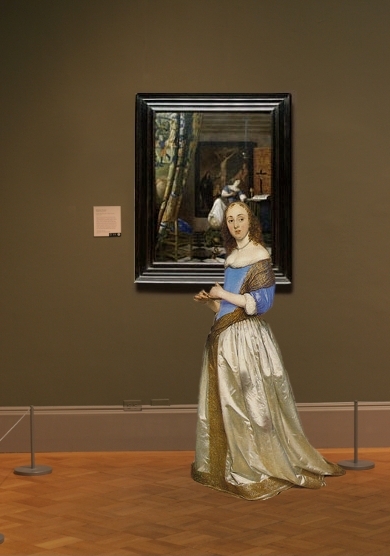The Allegory of Faith
(Allegorie op het geloof)c. 1670–1674
Oil on canvas, 114.3 x 88.9 cm. (45 x 35 in.)
Metropolitan Museum of Art, New York
acc. no. 32.100.18
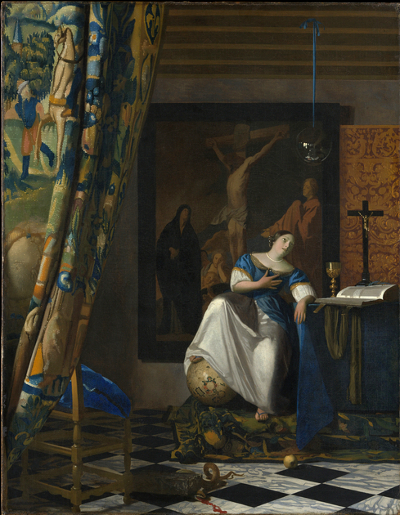
The textual material contained in the Essential Vermeer Interactive Catalogue would fill a hefty-sized book, and is enhanced by more than 1,000 corollary images. In order to use the catalogue most advantageously:
1. Scroll your mouse over the painting to a point of particular interest. Relative information and images will slide into the box located to the right of the painting. To fix and scroll the slide-in information, single click on area of interest. To release the slide-in information, single-click the "dismiss" buttton and continue exploring.
2. To access Special Topics and Fact Sheet information and accessory images, single-click any list item. To release slide-in information, click on any list item and continue exploring.
The hanging tapestry
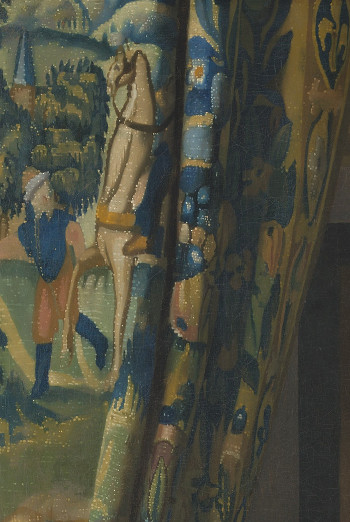
Perhaps no other tapestry in Vermeer's oeuvre has received such meticulous attention. The use of pulled-back curtain repoussoir motifs was a common technique to create a dramatic entrance and enhance the significance of the unfolding scene. Interestingly, tapestries were often displayed in Catholic places of worship, indirectly supporting the theory that this painting depicts a "hidden" Catholic church (schuilkerk).
This tapestry resembles examples of the Oudenaarde style, crafted in Belgium during the late 16th century. Oudenaarde tapestries were meticulously handwoven by multiple weavers on a horizontal loom, as opposed to the French vertical loom. Working from a carton copy of the design, the weavers could only fully appreciate the result once the tapestry was complete.
The process of weaving a tapestry was time-consuming. On average, a weaver could produce a piece of tapestry the size of a grown man's hand in a day. Initially, only a limited range of colors, mainly shades of green, were employed, leading to the term Verdures (French for "greenery").
In the upper part of the carpet, a gentleman with a hat is depicted leading an animal that has been described as either a horse or a camel. The presence of round highlights, known as pointillés, resembling the effects of a camera obscura image, is also noticeable. These highlights are skillfully scattered to simulate the texture of the tapestry's rough weave.
The glass orb
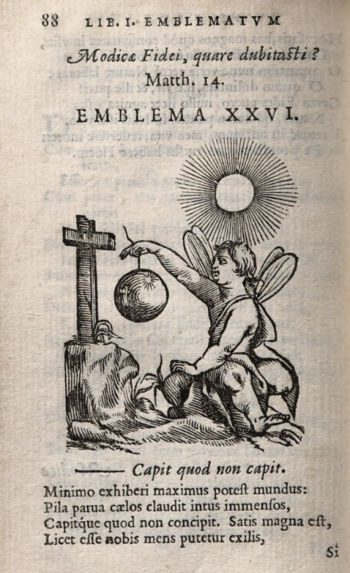
J. C. Jegher
after Erasmus Quellinus
Capit Quod Non Capit
from Willem Hesius,
Emblemata sacra de fide, spe, charitate
Antwerp, 1636
National Gallery of Art,
Washington
The significance of the glass orb, a captivating element in the painting, has puzzled scholars. Eddy De Jongh, the founder of the Dutch iconographic school, suggests that it highlights the painting's Jesuit themes. He proposes that Vermeer drew inspiration from an emblem book (Emblemata Amatoria - 1601) by Jesuit author Willem Hesius. In the emblem, a winged boy holds a sphere reflecting the sun and a crucifix nearby. The accompanying poem links the sphere's reflection of the vast universe to humanity's belief in God. Hesius aimed to entertain and instruct readers through the combination of images and text.
Upon closer observation, the globe reveals Vermeer's skillful representation of light through delicate strokes of colored paint, capturing the interplay of light on the partially shuttered windows and the studio floor.
A Baroque painting

In perhaps no other painting by Vermeer do we find evidence of the opulence and torment typical of the European Baroque conscience, despite his efforts to adapt them to his measured compositions. The overall result rarely satisfies the taste of modern observers, but it was differently perceived by the artist's contemporaries, as the painting was sold for the highest price ever paid for a Vermeer in the 17th century.
The calligraphically painted veins of the white marble floors are truly astounding when compared to those of his interiors from a few years earlier.
The gilt tooled leather panels
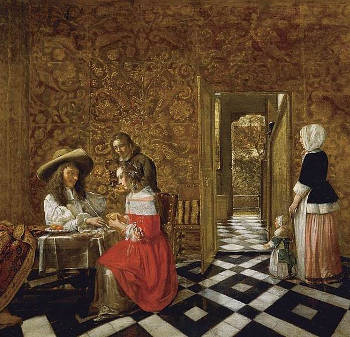
Merry Company at a Table
Hendrick van der Burch
55 x 69 cm.
Private collection
Luxury gilt-tooled leather panels served as wall coverings to counteract the damp white-washed walls of prosperous households. They are depicted in numerous Dutch interior paintings of the era, sometimes completely enveloping the walls. This results in a dazzling effect not typically associated with the austerity of Dutch interiors. In Vermeer's death inventory of movable goods, 7 ells (yards) of gilded leather are listed. They can also be seen behind the maid and mistress in the earlier Love Letter.

Gold-tooled leather involved tooling pieces of leather to raise intricate decorative patterns, followed by applying a thin layer of silver in delicate sheets onto the reliefs. Pigments were applied around the gilt pattern, and the entire piece was varnished.
The scene in Vermeer's painting, featuring only one leather panel, appears somewhat improvised. In fact, some scholars believe Vermeer intended to depict a makeshift, hidden Catholic church, prepared for celebrating the Holy Mass (see Special Topics entry below).
The snake
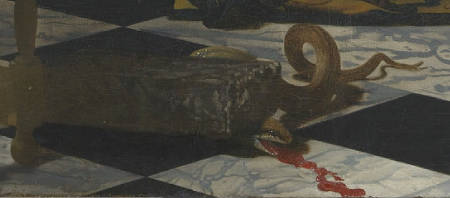
The serpent, symbolizing Satan, hell and death, spits blood onto the floor before being crushed by a marble slab. This slab represents the stone upon which Christ instructed Peter, also known as Simon, to establish His Church and establish the papacy.
In the foreground, Vermeer follows Cesare Ripa's Iconologia by showing a serpent (the Devil) crushed by the cornerstone of the church, that is, Christ (see Matthew 21:42, Mark 12:10, or Luke 20:17, which derive from Psalm 118:22). The nearby apple has been bitten and stands for original sin
The importance of Ripa's volume for painters of istoria cannot be overestimated, and it is no suprise that Vermeer might have consulted in the construction the Allegory of Faith. Ripa's volume stands as a monumental work in the field of iconography, casting a profound influence on visual symbolism in European art, especially during the Baroque period. Originally published in 1593 without illustrations in Rome, this emblem book served as a guide to understanding and representing allegorical figures in art.
Ripa provided descriptions of various allegorical figures, each representing abstract concepts, virtues, vices, emotions, and other elements of the human experience. For instance, he'd describe the allegory of "Charity" as a mother nursing her children or the allegory of "Fortune" as a woman atop a wheel.
What makes the "Iconologia" particularly significant is its comprehensive nature. Ripa didn't just detail the overall appearance of these figures but also explained the significance of every emblematic accessory they held, their poses, attire, and even expressions.
In later editions of the Iconologia, illustrations were added, offering visual representations of Ripa's descriptions. As the work gained popularity, it was expanded and translated into various languages, becoming an essential resource for painters, sculptors, and poets across Europe. Its vast impact can be seen in the many artworks of the 17th and 18th centuries, where artists drew directly from Ripa's descriptions to craft their allegories, ensuring a consistent visual language that would be immediately recognizable to their viewers.
The Crucifixion by Jacob Jordaens
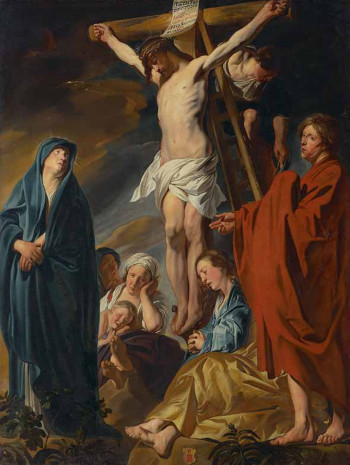
Christ on the Cross
Jacob Jordaens
c. early 1620s
Private collection, Antwerp
The painting on the back wall simplifies Jacob Jordaens' Crucifixion, a version of which exists in Antwerp. Vermeer has excluded the figure on the ladder and Mary Magdalene at the feet of Christ. His mother-in-law, Maria Thins, possibly owned the Jordaens painting or a copy of it, as the 1676 inventory lists a "large painting representing Christ on the Cross." It has been observed that Vermeer’s handling of paint in his early Christ in the House of Martha and Mary reflects that of Jordaens, a prominent Flemish Baroque painter and draughtsman active during the 17th century in Antwerp.
The painting is likely Jordaens's own reproduction or a copy by a different artist of an original work by an Antwerp painter. Differing from the original, Jordaens excluded Mary Magdalene and the man on the ladder, probably for compositional reasons.
The chalice, crown of thorns, crucifix & open Bible

While this large-scale painting is not a favorite among Vermeer enthusiasts, the Allegory of Faith holds surprises for the observant viewer, both in terms of iconography and technique. Similar to Vermeer's other later works, it displays an inclination toward simplifying and abstracting forms, combined with a vibrant yet controlled brushwork that diverges from the meticulous balance seen in his 1660s images. In these later works, intricate detailing gives way to pattern.
Art historian Valerie Hedquist posits that the table takes on the role of an altar, aligning with contemporary Roman Catholic descriptions of altars and their liturgical elements. Vermeer might have sought to depict the present-day Roman Catholic Church.
 On the altar items include a chalice, crucifix, an unexpected crown of thorns, a long silk green cloth that might be a priest's stole, and a large book often identified as the Bible. But given the other objects, it's likely the book is a Missale Romanum, crucial for the Mass ceremony. During Vermeer's time, the Mass celebrated the Eucharist, symbolizing Christ's sacrifice. Artworks above altars typically showed the Crucifixion, Assumption of the Virgin or the Adoration of the Magi. The Crucifixion was popular for its ties to the Eucharist and redemption from sin.
On the altar items include a chalice, crucifix, an unexpected crown of thorns, a long silk green cloth that might be a priest's stole, and a large book often identified as the Bible. But given the other objects, it's likely the book is a Missale Romanum, crucial for the Mass ceremony. During Vermeer's time, the Mass celebrated the Eucharist, symbolizing Christ's sacrifice. Artworks above altars typically showed the Crucifixion, Assumption of the Virgin or the Adoration of the Magi. The Crucifixion was popular for its ties to the Eucharist and redemption from sin.
Such a crucifix was a rarity in Protestant households, making appearances predominantly in Roman Catholic or hidden churches. In the context of Dutch Reformation, showcasing and venerating a crucifix was unusual. In Dutch missals, Christ’s crowning with thorns is linked to the moment in the Eucharistic rite when the priest covers the chalice prior to consecrating the wine. Through the miracle of transubstantiation, this libation is transformed into the Lord’s actual blood. Moreover, the ebony crucifix and the large picture on the back wall signify Christ's body, the host in the Mass.
Th crucifix in the present painting likely represents a 17th-century crucifix from Augsburg, where gilded bronze crucifixes set against ebony crosses were prevalent. Contrarily, no images of the Virgin Mary appear in Vermeer's extant paintings. To foster devotion and deter impure thoughts, a crucifix was often hung in the corner of a marital bedroom of Catholic homes, accompanied by a painting of the Virgin Mary near the bed's head. In the voorhuis (great hall) of Vermeer's residence, these two devotional items, an "ebony crucifix" and a depiction of "Christ's Mother," were listed in the probate inventory taken two months after the artist's death. Yet, during his era, Mary's portrayals were highly revered in Catholic traditions, often found in prominent room inventories, especially close to the bed.
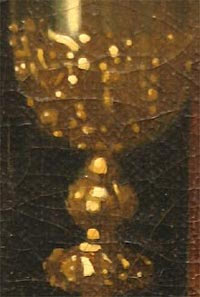
The upper part of the chalice showcases the artist's endeavor to blend texture using a series of staccato dots and dashes, aiming to conjure the reflections of its intricate relief design.
The terrestrial globe

Mary Magdalen Turning from the World to Christ
Jan van Bijlert
c. 1625–1630
Bob Jones University, Greenville, South Carolina
Vermeer critics now believe that contemporary illustrated mass books, Jesuit writings and primary sources regarding the Roman Catholic mission to the Netherlands suggest that Vermeer depicted a genre scene serving as a domestic church setting where the Eucharistic miracle of transubstantiation is celebrated.
The terrestrial globe is identical to the one depicted in Vermeer's Geographer, fabricated in 1618 by Jacob Hondius. In the present painting, the allegorical figure of Faith rests her foot on the continent of Asia. According to many scholars, Vermeer seems to have followed Cesare Ripa's description of Faith "who has the world under her feet" by including the terrestrial globe.
In a meticulous and in-depth study of the Catholic backdrop of the Allegory of Faith, Valerie Hedquist provides convincing pictorial and iconographic evidence that supports the identification of the richly attired woman more specifically as the penitent Saint Mary Magdalene, representing the figure of faith. She points out that Vermeer may have had in mind a penitent Magdalene by Jan van Bijlert.

Het masker vande wereldt afgetrockenst
"Siet hoe hy, niet hoe ghy"
Adriaen Poirters
Antwerp 1646
Details from both artists' works appear in an emblem from the 1646 Het masker vand wereldt afgetrocken (The mask of the world torn away), by Jesuit priest Adriaen Poirters. In the twelfth print of the book, a worldly woman in the foreground admires herself in a mirror, while in the background, a figure identified as Mary Magdalene gazes at an image of Christ crowned with thorns. In this representation, Mary Magdalene holds a crucifix in her left hand and rests her foot on a terrestrial globe. The globe, the crucifix and the crown of thorns, associated with Mary Magdalene's emblem, reappear in Vermeer's painting compares two women: one vain, made up and dressed to the nines standing before her mirror; the other a devout believer sitting before an image of the sudarium. "See how he is, not how you are," says the motto accompanying the image, whereupon Poirters explains that "I have found it good to set only the veil of Saint Veronica in a black ebony frame, and to hang it up for you...This is the Mirror in which a Christian soul must discover her vanity and imperfection."
Het Masker was considered an emblem masterpiece when first published in 1646. Given its numerous editions and Vermeer's close ties with the Jesuit community in Delft, he would have been familiar with it.
Thus, Vermeer's Magdalene stands between the celestial globe suspended by the blue ribbon over her head (symbolizing the heavens) and the terrestrial globe (symbolizing the earth) under her feet.
The rhetorical gesture of the figure: a precedent
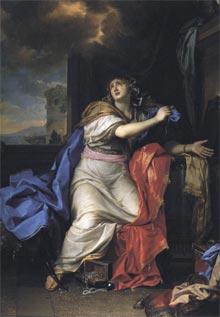
The Repentant Magdalen
Charles le Brun
1655
52 x 171 cm.
Musée du Louvre, Paris
Modern critics have always drawn attention to the rhetorical gesture and modest technique reserved for the figure representing the Catholic Faith. However, to understand Vermeer's figure as it was conceived, we must examine another part of Vermeer's composition: the Crucifixion by Jacob Jordaens, which hangs prominently in the background.
According to art historian Valerie Hedquist, Vermeer altered Jordaens' original composition in two significant ways. Firstly, he eliminated a figure on a ladder in the background of Jordaens' work, and secondly, he removed or obscured the figure of Mary Magdalene mourning at the bottom of the cross between Christ and St. John in Jordaens' composition. Vermeer's figure of faith assumes the position of the seated Mary Magdalene in the background painting and comes to life as the penitent saint within Vermeer's domestic church interior.
Italian and French art provided scores of appropriate images that may have inspired Vermeer, although he may not have seen the works themselves. Painted copies and engraved prints of important artworks circulated throughout Europe, and many painters collected engravings as a sort of cookbook for anatomy and gestures.
The chair & blue cushion

Although the composition of the Allegory of Faith is clearly based on Vermeer's celebrated Art of Painting, it lacks, at least to the modern eye, artistic conviction.
The chair and blue cushion

Although the composition of the Allegory of Faith is clearly based on Vermeer's celebrated Art of Painting, it lacks, at least to the modern eye, artistic conviction. The blue cushion and chair are both props that can be seen in other works by Vermeer, but how they are illuminated does not seem to be coherent with the rest of the painting. Perhaps the chair was introduced to neutralize the forced effect of the perspectival recession created by too many black and white marble tiles.
An improvised private Catholic altar?

In the setting of an improvised private Catholic church, known as schuilkerken, made to celebrate the Holy Mass, a crucifix could not be absent. Vermeer also included a large open book with gold clasps that resembles contemporary missals, which provided the priest with the complete rite of the mass. Other than the re-enactment of the Passion on the altar, Vermeer referred to Christ's Passion by placing a true crown of thorns on the opened missal.
The detail of the missal testifies to how far Vermeer had moved from direct observation towards stylization in his late pictures.
In the 17th century Netherlands, as Calvinism surged and the Dutch Reformed Church emerged dominant, Catholicism was officially pushed out of the public sphere. Yet, the Dutch Republic, known for its relative religious tolerance, allowed for discreet private worship. This unique set of circumstances led to the creation of schuilkerken, or hidden churches. These clandestine places of worship looked like ordinary buildings from the outside, but within, they were ornate sanctuaries for Catholics to practice their faith. As long as Catholics remained unobtrusive and fulfilled their civic duties, like tax-paying, authorities often looked the other way. However, by the 19th century, as religious tensions relaxed, the role of hidden churches waned. With Catholicism regaining its legal status, public worship became the norm once more.
The tapestry on the pedestal

Such an elaborate carpet would not typically be found on the floor of a Dutch house. The accumulation of ecclesiastic objects in this makeshift setting suggests an impromptu Catholic church within a private house, prepared for the celebration of the Holy Mass.
Contemporary accounts concerning proper liturgical articles for such Masses indicate that the altar should be placed on an elevated platform and carpeted, as seen in Vermeer's Allegory of Faith. Hanging tapestries were also recommended. The cushion on the standing chair might have served as a kneeling cushion intended for some parishioners, even though cushions are present on other chairs in Vermeer's interiors.
The gilt tooled leather panel

Merry Company at a Table
Hendrick van der Burch
55 x 69 cm.
Private collection
Luxury gilt-tooled leather panels served as wall coverings to counteract the damp white-washed walls of prosperous households. They are depicted in numerous Dutch interior paintings of the era, sometimes completely enveloping the walls. This results in a dazzling effect not typically associated with the austerity of Dutch interiors. In Vermeer's death inventory of movable goods, 7 ells (yards) of gilded leather are listed. They can also be seen behind the maid and mistress in the earlier Love Letter.
Gold-tooled leather involved tooling pieces of leather to raise intricate decorative patterns. The technique involved embossing dampened leather (usually calf or sheepskin) using carved wooden or metal tools. Once embossed, gold leaf or foil was applied to the raised design, adhering to the leather with the help of a mordant, usually a kind of gum or size. This gave the leather a rich, decorative appearance.

Due to the organic nature of leather, relatively few original Dutch gilt-tooled leather panels have survived intact from the 17th century. However, those that have are often in museums or private collections and offer a glimpse into the opulence and artistic taste of the Dutch Golden Age. While walls were a common application, gilt-tooled leather was also used for bookbindings, furniture coverings, and various other decorative objects.
The scene in Vermeer's painting, featuring only one leather panel, appears somewhat improvised. In fact, some scholars believe Vermeer intended to depict a makeshift, hidden Catholic church, prepared for celebrating the Holy Mass (see Special Topics entry below).

The wooden rafters
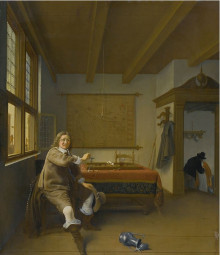
A Man in an Interior Holding a Glass, Two Servants Kissing in a Doorway
Isaack Koedijck
1648
Oil on panel, 66 x 55 cm.>
Private collection (?)
Various critics argue that Vermeer did not always faithfully depict the physical reality of his studio, but rather a revised version tailored to the compositional and thematic requirements. One example is the representation of wooden beams in his rooms. They contend that Vermeer depicts ceiling beams running horizontally across the picture from left to right, whereas in typical Delft houses of the period, they would have run perpendicularly away from the viewer and towards the far wall.
However, Philip Steadman, a London architect and author of a key text on Vermeer and the camera obscura, counters this by suggesting that such an arrangement is plausible for many Delft houses, which were narrow in plan (around 4 or 5 meters wide), although not for all houses in Delft. Steadman points out, "Willem Weve, an architectural historian working for the Delft municipality, maintains that domestic construction was not standardized in the city of Delft in the 17th century; but that the type of ceiling shown by Vermeer is one among several arrangements used in houses, and surviving examples can indeed be found. The timber members are indeed small beams, probably of pine, supported by a wall plate over the windows, as seen at the top left of The Music Lesson. They would have been relatively deep, so the floorboards which they support are not visible. It is likely, according to Weve, that the beams were supported at their other ends on a wall which would be on the right of Vermeer's pictures but is always out of sight. Wilfried van Winden is a partner in the Delft architectural practice Molenaar and van Winden, which specializes in restoration projects in the city. Van Winden's own house in the center of Delft, dating from the 17th century, has ceiling beams as Vermeer shows them."
Tiles
Despite their realistic appearance, there is no doubt that Vermeer invented the marble tiles that are so characteristic of his interior scenes.
Opulent, gleaming marble flooring was, in fact, one of the most recurrent motifs in 17th-century genre interior painting. The detailed rendering of marble flooring allowed artists to demonstrate their prowess in geometric perspective, and the intricate patterns, reflections and the play of light on polished marble surfaces were among the most challenging effects to capture accurately. In the present work, the white tiles are arranged in Maltese crosses, which create a lighter effect and accentuate the sensation of spatial recession.

Although the shapes of the tiles in the Allegory of Faith are in perfect accordance with the laws of geometric perspective, the rendering of the veins is particularly audacious, almost an artistic caprice, far removed from the more carefully painted renditions of his earlier works. Together with the rhythmic movement of the snake's twisted body, the wiggling veins of the floor tiles constitute perhaps one of the most unsettling passages in Vermeer's oeuvre. This intriguing "quasi-calligraphic" freedom in the depiction of marble veining is also evident in the tiles of Vermeer's Love Letter. To highlight this effect, Vermeer applied flowing strokes of light gray over the white tile painted a day prior and fully dried lending them a crisp, improptu air. Had the veins been painted directly into the wet layer beneath, they would have intermingled, resulting in a softer effect. Particularly important was the distribution of the white and black tiles, which Vermeer sometimes changed from painting to painting.
While marble was indeed a luxury commodity, affluent households, particularly those in urban centers, might boast genuine marble floors, but they were strictly confined to the voorhuis (front room) where they would be appreciated by visitors. Otherwise, to study the effects of real marble flooring, Vermeer would have had to visit a public building, such as the Stadhuis in Delft, where one of the rooms is adorned with genuine marble tiles.
Marble was particularly expensive, so it would have been wildly out of reach of Vermeer's financial possibilities. This is due to the fact that marble used in the Netherlands was often imported. The Dutch Republic did not have native marble quarries, although some marble could be sourced from neighboring regions, including the Southern Netherlands (present-day Belgium), which had its own renowned quarries. Italian marble, especially from regions like Carrara (known for its high-quality white marble), was particularly prized.
Tiles
Despite their realistic appearance, there is no doubt that Vermeer invented the marble tiles that are so characteristic of his interior scenes.
Opulent, gleaming marble flooring was, in fact, one of the most recurrent motifs in 17th-century genre interior painting. The detailed rendering of marble flooring allowed artists to demonstrate their prowess in geometric perspective, and the intricate patterns, reflections and the play of light on polished marble surfaces were among the most challenging effects to capture accurately. In the present work, the white tiles are arranged in Maltese crosses, which create a lighter effect and accentuate the sensation of spatial recession.

Although the shapes of the tiles in the Allegory of Faith are in perfect accordance with the laws of geometric perspective, the rendering of the veins is particularly audacious, almost an artistic caprice, far removed from the more carefully painted renditions of his earlier works. Together with the rhythmic movement of the snake's twisted body, the wiggling veins of the floor tiles constitute perhaps one of the most unsettling passages in Vermeer's oeuvre. This intriguing "quasi-calligraphic" freedom in the depiction of marble veining is also evident in the tiles of Vermeer's Love Letter. To highlight this effect, Vermeer applied flowing strokes of light gray over the white tile painted a day prior and fully dried lending them a crisp, improptu air. Had the veins been painted directly into the wet layer beneath, they would have intermingled, resulting in a softer effect. Particularly important was the distribution of the white and black tiles, which Vermeer sometimes changed from painting to painting.
While marble was indeed a luxury commodity, affluent households, particularly those in urban centers, might boast genuine marble floors, but they were strictly confined to the voorhuis (front room) where they would be appreciated by visitors. Otherwise, to study the effects of real marble flooring, Vermeer would have had to visit a public building, such as the Stadhuis in Delft, where one of the rooms is adorned with genuine marble tiles.
Marble was particularly expensive, so it would have been wildly out of reach of Vermeer's financial possibilities. This is due to the fact that marble used in the Netherlands was often imported. The Dutch Republic did not have native marble quarries, although some marble could be sourced from neighboring regions, including the Southern Netherlands (present-day Belgium), which had its own renowned quarries. Italian marble, especially from regions like Carrara (known for its high-quality white marble), was particularly prized.
Apple

There is, of course, little doubt that in planning the iconographic construction of the Allegory of Faith, Vermeer, like every other painter who worked in the "history" painting mode, consulted the well-known Iconologia by Cesare Ripa. Ripa describes a stone slab crushing a snake; this is the cornerstone of the Church, a metaphor for Christ, who tramples the serpent, signifying Satan, his adversary. The bitten apple on the floor in the painting symbolizes humankind’s original sin (an allusion to the fruit of the Tree of the Knowledge of Good and Evil from the Garden of Eden). Lastly, Ripa invokes Christ’s crucifixion as a biblical reference for his personification of Faith.
Iconologia consists of descriptions of various abstract concepts, virtues, vices, emotions and other themes as personified figures. Each entry in the book describes the visual appearance of the allegorical figure, its attributes and its symbolic significance. For example, Ripa would describe "Hope" as a woman looking upwards, holding an anchor, signifying steadfastness and stability.
Over the years, Iconologia became a primary reference for painters, sculptors and poets who worked primarily with classical and allegorical subject matter. The images and descriptions provided by Ripa resulted in the standardization the way ideas and abstract concepts could be visually represented in the arts.
Chalice

One of the most striking passages in the current work is the depiction of the gilt chalice, which, had it existed, would most likely have been the property of the Jesuit priesthood in Delft, perhaps lent to Vermeer for the occasion. The body of the chalice is rendered with an almost unmodulated layer of dark ochre paint, atop which sit almost abstract dabs of light yellow paint. These might appear haphazardly applied, but they conjure an extraordinary effect, evoking the gleam of precious metal. Vermeer experimented with this technique earlier, evident in the gilt sound hole of the Baroque guitar in another of his works, "The Guitar Player."
The chalice also symbolizes contemporary worship within this domestic setting. For Roman Catholics, the chalice holds the wine that is believed to be miraculously transformed into Christ's blood during its consecration on the altar during Mass.
special topics
Critical assessment
In order to appreciate the full rich meaning of the Allegory of Faith, one must acknowledge the community of believers at the Delft Papists' Corner. Vermeer's painting of faith, the real presence of Christ on the altar and the penitent Saint Mary Magdalene, met the needs of the Catholic community in a private devotional setting. Vermeer's work is a finely painted masterpiece that ties Vermeer to his community, family and home. In the domestic sanctuary depicted in Vermeer's Allegory of Faith, the New Testament of Christ is renewed in the Holy Sacrament of the altar. The open curtain reveals the altar on which the historical Crucifixion depicted in the painting on the back wall is perpetually renewed in the sacrifice of the Holy Mass. The figure of Faith, Mary Magdalene, personifies the enduring belief in the miracle of the altar, the real presence of Christ's body and blood.
Valerie Lind Hedquist. "The Real Presence of Christ and the Penitent Mary Magdalen in the 'Allegory of Faith' by Johannes Vermeer." Art History 23 (September 2000).
The signature
No signature appears on this work.
(Click here to access a complete study of Vermeer's signatures.)
Dates
1672–1674
Albert Blankert, Vermeer: 1632–1675, 1975
c. 1671–1674
Arthur K. Wheelock Jr., The Public and the Private in the Age of Vermeer, London, 2000
c. 1670–1672
Walter Liedtke, Vermeer: The Complete Paintings,
c. 1672–1674
Wayne Franits, Vermeer, 2015
c. 1670–1674
Pieter Roelofs & Gregor Weber, VERMEER, Amsterdam, 2023
(Click here to access a complete study of the dates of Vermeer's paintings).
Technical report
The support is fine, plain-weave linen with a thread count of 14.5 x 12 cm², and it has been wax/resin lined. The original tacking edges are present.
The light gray-brown ground contains chalk, lead white and umber.
Underdrawing lines, which appear to be in black chalk, are visible between the floor tiles and the line separating the ceiling from the wall.
The paint has been thinly and smoothly applied, though some impasto in the curtain and in the blue areas is apparent. Areas of the curtain were painted wet-in-wet, as were some of the flesh tones. The vanishing point of the painting is visible as a small depression in the paint layer.
Johannes Vermeer (exh. cat., National Gallery of Art and Royal Cabinet of Paintings Mauritshuis - Washington and The Hague, 1995, edited by Arthur K. Wheelock Jr.)
Provenance
- Herman Stoffels van Swoll, Amsterdam (before 1698);
- Van Swoll sale, Amsterdam, 22 April, 1699, no. 25;
- sale, Amsterdam 13 July, 1718, no. 8;
- sale, Amsterdam, 19 April, 1735, no. 11;
- [David Ietswaart, until 1749];
- Ietswaart sale, Amsterdam, 22 April, 1749, no. 152 (to Ravensberg);
- private collection, Austria (1824);
- Dimitri Shchukin, Moscow (1899, probably as by Eglon van der Neer);
- [Wächtler, Berlin, 1899, as by Eglon van der Neer, sold to Bredius];
- Abraham Bredius, The Hague (1899–1928, as by Vermeer, on loan to the Mauritshuis, The Hague, 1899–1923, The Hague, on loan to the Museum Boijmans Van Beuningen, Rotterdam, 1923–1928, sold to Kleinberger);
- [Kleinberger, Paris, 1928, sold to Friedsam];
- Michael Friedsam, New York (1928-d.1931);
- The Metropolitan Museum of Art, New York, The Friedsam Collection, Bequest of Michael Friedsam, 1931 (acc. no. 32.100.18).
Exhibitions
- New York November 15, 1932–April 9, 1933
The Michael Friedsam Collection
The Metropolitan Museum of Art
no catalogue - Delft May 17–August 12, 1952
Prisma der bijbelse kunst
Stedelijk Museum 'Het Prinsehof'
216–217, no. 324 and ill. - Dallas October 10–30, 1953
Trompe l'Oeil: Paintings that Fool the Eye by Masters from Vermeer to Dali
Dallas Museum of Art - Washington D.C November 12, 1995–11 February, 1996
Johannes Vermeer
National Gallery of Art
190–195, no. 20 and ill. - The Hague March 1–June 2, 1996
Johannes Vermeer
Mauritshuis
190–195, no. 20 and ill. - New York March 8–May 27, 2001
Vermeer and the Delft School
Metropolitan Museum of Art
no. 77 - London June 20–September 16, 2001
Vermeer and the Delft School
National Gallery
no. 77. - New York September 18, 2007–January 6, 2008
The Age of Rembrandt: Dutch Paintings in The Metropolitan Museum of Art
Metropolitan Museum of Art
no catalogue - New York September 9–November 29, 2009
Vermeer's Masterpiece 'The Milkmaid'
Metropolitan Museum of Art
no. 10 and ill. - Rome 27 September, 2012–20 January, 2013
Vermeer: Il secolo d'oro dell'arte olandese
Scuderie del Quirinale
218, no. 50 and ill. - Budapest 31 October, 2014–15 February, 2015
Rembrandt and the Dutch Golden Age
Szépművészeti Múzeum - Paris February 22–May 22, 2017
Vermeer and the Masters of Genre Painting: Inspiration and Rivalry
Musée du Louvre - Osaka 13 November 2021–January 16, 2022
European Masterpice from The Metropolitan Museum of Art, New York
- Tokyo Feruary 9–May 3, 2022
European Masterpice from The Metropolitan Museum of Art, New York - Amsterdam February 10– June 4, 2023
VERMEER
Rijksmuseum
no. 32 and ill.
(Click here to access a complete, sortable list of the exhibitions of Vermeer's paintings).
A Jesuit commission?
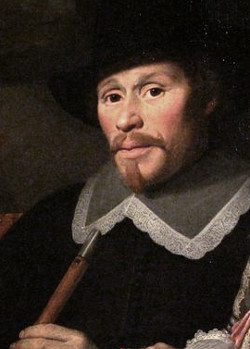
Portrait of Michiel van der Dussen, his Wife, Wilhelmina van Setten and their Children (detail)
Hendrick Cornelisz. van Vliet
1640
159 x 210 cm.
Gemeente Musea Delft;
Collection Stedelijk
Museum Het Prinsenhof, Delft
Nearly every scholar concurs that the Allegory of Faith was commissioned, presumably, by someone with Catholic ties. Some believe that a Jesuit publication that contains the only contemporary reference to a glass ball (which hangs from the ceiling) and the indisputable Jesuit leanings of Vermeer's strong-willed mother-in-law point towards the Jesuits themselves. But, as Walter Liedtke points out, Jesuits were more inclined towards conventional imagery. He suggests Michiel van der Dussen, a well-to-do Catholic and important supporter of the Delft Bagijnhof, a community of Catholic lay-women, as a likely candidate. These women lived like nuns but didn't take formal vows, dedicating themselves to prayer and charitable works.

Bagijnhof, Delft
The Bagijnhof in Delft is a historic courtyard dating back to the 13th century, originally established for the Bagijnen, a Catholic lay sisterhood. One of the unique features of the Bagijnhof is its entrance. To access it, you pass through a building from the main street, which leads to the serene courtyard. This entrance gives the Bagijnhof a secluded and peaceful atmosphere, even though it's located in the heart of the city. Notably, it houses the "Hidden Church" (Bagijnhofkerk), a result of the Protestant Reformation's restrictions on Catholic church visibility. Today, while it retains its historical charm, it serves as a residential area for Delft residents.
While Catholics still formed a sizable segment of the population when the United Provinces came into being, they were gradually submerged in the rising tide of Protestantism, particularly Calvinism. The Catholic faithful were compelled to worship in private—their churches were stripped of their altars and often taken over for use by Protestants. In these circumstances, the Church could no longer furnish the rich commissions that had nourished artists since the beginning of the Renaissance.
Cesar Ripa's Iconologia
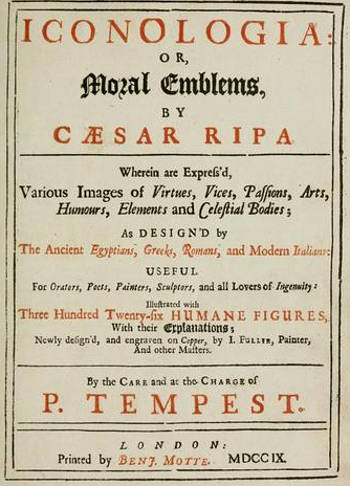
Title page of Caesare Ripa'
Iconologia or Moral Emblems
English edition, 1709
There is little doubt that Vermeer derived some components of the Allegory of Faith from the 1644 Dutch translation of Ceasar Ripa's Iconologia, a well-known guide to symbolism. The Iconologia was used by orators, artists and poets to give substance to qualities such as virtues, vices, passions and the arts and sciences. The concepts were arranged in alphabetical order by their Italian names. It was very influential in the 17th century and went through numerous editions—9 Italian editions and 8 editions in other languages. Both the text and the emblems vary greatly from edition to edition.
However, Vermeer did not adhere blindly to the prescriptions of Ripa's prescriptions. None of the four allegorical figures of Faith in the Iconologia match exactly. Ripa recommends that the figure of Faith, representing the most important virtue, should be painted with white, symbolizing light and purity. Blue, which Vermeer used along with white, represents the heavenly sky. The hand posed on Faith's breast indicates that living faith lies within the heart. The cornerstone which has crushed the snake represents Christ who defeats Satan.
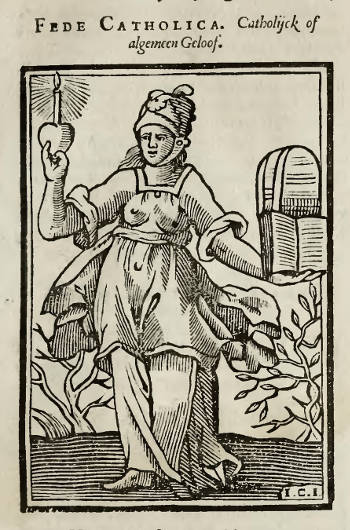
Fede Catholica
from Cesare Ripa
Iconologia
1644, Amsterdam
Other significant elements of Vermeer's painting, such as the glass ball and the crucifix, are absent from Ripa's volume, while the Eucharistic chalice and Missale refer to the Holy Mass. However, Vermeer adhered to Ripa's description of Faith literally, depicting her as having "the world under her feet" by including the terrestrial globe.
It is likely that Vermeer had previously consulted the Iconologia for the figure of the muse Clio in his Art of Painting.
A misunderstood painting
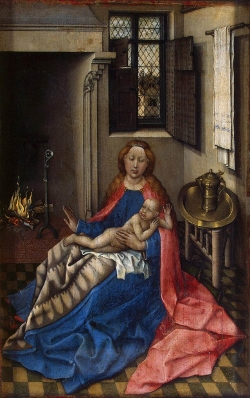
Madonna with the Child by a Fireplace
Robert Campin
1433–1435
34 x 24 cm.
The Hermitage, St. Petersburg
Contemporary critics often highlight the contrived nature of the Allegory of Faith, positioning it among Vermeer's less compelling works. It doesn't appear to resonate strongly with the public either, despite containing passages of exquisite pictorial craftsmanship. However, one should approach the presumed lack of artistic engagement with caution. Tastes in subject matter and style shift subtly over centuries, and it seems that Vermeer's contemporaries held a different perspective on the painting. In a posthumous sale, the Allegory of Faith was described as "powerfully and glowingly painted," a sentiment reinforced by the substantial price it fetched— the highest documented sum (400 guilders, enough to purchase a modest Dutch house) for a Vermeer painting sold during or shortly after the artist's active period.
John Michael Montias has speculated that the artist's residence might have doubled as a place of worship, and the painting's subject could be inspired by a real-life scenario. As Vermeer authority Walter Liedtke points out, the painting might align with a longstanding Netherlandish tradition of depicting religious events within the confines of contemporary households. The arrangement of improbable objects in the composition suggests that the setting might reflect the nature of the schuilkerk (hidden church) within Dutch homes, serving as a temporary space for Catholics to celebrate the Holy Mass, which was forbidden by law from public celebration.
Vermeer's Catholic marriage

The Jesuit Church on the Oude Langendijk
Abraham Rademaker
c. 1670
Brush and gray ink, 13.2 x 20.2 cm.
Gemeentearchief, Delft
Over the past decades, much discussion has revolved around Vermeer's religious beliefs. Little is known about the painter's religious inclinations prior to his marriage, save for his baptism on 31 October 1632 in the Reformed Church in Delft. Nevertheless, art historians posit that the young artist likely embraced Catholicism upon marrying Catharina Bolnes, even though the available information is largely circumstantial.
Maria Thins, Vermeer's mother-in-law, stood as a fervent Catholic and presumably played a pivotal role in his conversion. Having been raised in the heartland of Dutch Catholicism, Gouda, she also held a position of influence in Delft's patrician circles. In Gouda, her family clandestinely held masses at their residence, known as De Trapjes (The Little Steps). Her sister even became a nun in Louvain.
Given Vermeer's transition to Catholicism, it seems logical that he would settle in the Papists' Corner (Papenhoek), where Maria Thins owned a spacious house. The inn Mechelen, where he resided with his family before marriage, was primarily frequented by Protestants and was not conducive to nurturing Catholic faith in their children. The Papist Corner wasn't a confined area; rather, many families willingly chose to reside there, enjoying prosperity. Art historians continue to debate whether the Vermeer family lived in the corner house called Trapmolen or the Groot Serpent, whichever house it may have been, Vermeer had become part of the Catholic community in the Papenhoek.
In the mid-17th century, despite religious prohibitions, Delft had a significant Catholic population, with 5,500 of its 23,000 residents identifying as Catholic. The city had two schuilkerken (hidden Catholic house churches) located in the old beguinage, named after the saints St Hippolytus and St Ursula. Near the New Church, there was an area known as the Papenhoek (Papists’ corner), where affluent Catholics owned properties and often rented them to fellow Catholics. Notable Catholic families, like the Thins (Vermeer's monther-in-law), owned house(s) in this area. These families supported each other and the Jesuits living among them. However, Jesuits couldn't own houses. Their residence, hidden behind buildings on the Oude Langendijk, had a house church that could accommodate 700 worshippers.While the municipality of Delft didn't actively suppress Catholics, they lacked full freedom in their practices and were barred from public celebration of the Holy Mass. Vermeer's marriage to Catharina took place in a hidden church in the nearby village of Schipluiden, a Catholic enclave.
Although not a common occurrence, religious conversions did happen. Perhaps Vermeer's conversion was an inevitable outcome. The Council of Trent had decreed marriages between Catholics and non-Catholics null and void. Hence, a union between Catharina, a Catholic and Vermeer, a non-Catholic, would not have been recognized. According to the Council of Trent, the Roman Catholic Church consistently upheld the dogma of Holy Matrimony as a Sacrament, a stance at odds with the Protestant Church (see Martin Luther, Von den Ehesachen, Wittenberg 1530). In 1648, Phillip Rovenius, apostolic vicar to The Netherlands, likened the marriage of a Catholic to a nonbeliever to a pact with the devil.
The motivation behind Vermeer's conversion remains elusive. Was it to appease his influential and strong-willed mother-in-law, Maria Thins? Or did Vermeer's conversion stem from an inherent spiritual calling? We'll likely never ascertain the exact reasons. Most probably, it served the best interests of both families.
Anti-Catholicism in the United Provinces
Vermeer's parents tied the knot in 1615, marking the culmination of the suppression of public Catholic worship in Delft. Despite national decrees prohibiting Catholics from holding public office, many regions of the Netherlands staunchly maintained their Roman Catholic faith. In the face of adversity, Dutch Catholics persevered, maintaining their religious practices and ensuring the Catholic upbringing of their children throughout the 17th century. Notably, major cities such as Amsterdam, Haarlem and Utrecht, driven by commercial considerations, curtailed repeated efforts to enact anti-Catholic laws. While religious intolerance persisted within the United Provinces, Dutch Catholics generally enjoyed noteworthy liberties in comparison to religious minorities elsewhere in early modern Europe. Although occasional enforcement of penal laws and susceptibility to extortion were concerns, the situation could have been far graver.
Upon his marriage to Catharina Bolnes, Vermeer likely converted to Catholicism, a decision seemingly bereft of adverse repercussions on his career. Leonaert Bramer, a prominent painter in Delft and a friend of the Vermeer family, as well as Jan Steen, a renowned painter of Dutch domestic life, were both recognized Catholics. Johannes and Catharina's wedding took place on Easter Sunday, 20 April 1653, in Schipluiden, an hour's walk from Delft. In Schipluiden, they could be married by a Catholic priest, likely a Jesuit. Jesuits in Delft had access to their main residence and four other hidden church rooms or house churches in the surrounding Delfland area, including one in the offshore village Hodenpijl, where the ceremony could have been performed by one of three fathers, all of whom were assigned to the Oude Langendijk in Delft.
The Jesuits in Delft
The Jesuits, who initiated their first Dutch mission in 1592, established a permanent presence in Delft in 1612. By 1650, the Catholic community in Delft faced a limited "choice" of three schuilkerken (hidden churches). Among these, two located in the Bagijnhof along the Oude Delft canal were constructed between 1630 and 1650. They were dedicated to Saint Hippolytus and Saint Ursula, managed by secular priests. Another hidden church emerged in 1617 within an old warehouse on Oude Langendijk. This one was dedicated to Saint Josef and administered by the Jesuits.
As Delft's population grew, the concealed church on Oude Langendijk needed expansion around 1835, eventually transforming into a waterstaatskerk, known today as the Maria Jesse Church. In this process, the house where Vermeer and his family had resided nearly three centuries earlier was demolished. As a note, a waterstaatskerk is a type of Dutch church built in the 19th century under government oversight, following standardized designs, to replace outdated or small churches. In contrast, schuilkerken were hidden churches used by Catholics during religious persecution. These covert spaces were concealed within buildings to enable secret worship and evade authorities.
The positon of Faith's foot on the terrestrial globe: does it hide a message?

Philippe Sevestre recently highlighted an intriguing detail: Faith is depicted with bare feet, which, upon initial observation, resemble beach flip-flops. Intriguingly, the right foot is positioned over Japan. These aren't just any flip-flops but are reminiscent of the Japanese Zori tatami, sandals crafted with rice straw soles. In the United Provinces, Calvinist dominance curtailed Catholicism. Similarly, in Japan, Dutch Calvinists collaborated with the shogunate to quell a 1637 uprising by Japanese Catholics. Despite these suppressions, Catholicism, once subdued in Japan, would find its resurgence in both Europe and Asia, a profound message encapsulated in the artwork.
For context, the Jesuits, through the Society of Jesus, embarked on missions to propagate the Catholic faith globally. In 1540, Jesuit missionary Francis Xavier departed from Portugal, journeying to India and subsequently to Goa, Ceylon, Malacca, the Moluccas, and Japan. There, he endeavored to convert the locals and founded mission centers. Tragically, he succumbed to an infection while traveling to China. A poignant chapter in history unfolded in 1597 when 26 martyrs faced crucifixion in Nagasaki, decreed by Shogun Toyotomi Hideyoshi. The subsequent Shimabara Rebellion in 1638, led by Catholics, culminated in the tragic massacre of approximately 37,000 individuals, marking a somber halt to the Christian movement in 17th-century Japan.
Whether the placement of Faith's foot is intentional remains a matter of debate. However, considering Vermeer's conversion to Catholicism and his residence in the Catholic quarter of Delft, known as the Paepenhoek, it's likely he was well-versed in the history of the Jesuit settlements in Japan, especially given the trade relations between the Dutch VOC and Japan.
Listen to period music
![]() Jan Dismas Zelenka (1679–1745)
Jan Dismas Zelenka (1679–1745)
"Kyrie" from: Missa Sanctissimae Trinitatis, ZWV 17 (868 KB)
Musica Florea. Marek Stryncl


